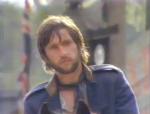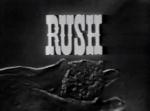
Latest Issues
AbstractHistoryArchive Description
One of Australia's earliest television dramatisations of its gold-rush era, Rush is, as Don Storey points out in his Classic Australian Television, in many ways two entirely separate programs: between series one and series two, the setting shifts from the Victorian goldfields to a New South Wales mining town, and jumps forward from the 1850s to the early 1860s. However, both series take place in the same universe, use the same chronology, and have a clear internal coherence, centred on the continuing character of Sergeant Robert McKellar. Therefore, they are generally treated as two separate series of a single program.
(The differences in cast, crew, writers, and directors between the two series are given in detail in the film details section below.)
With its enormous, intricate, expensive, and accurate sets, costumes, and props, Rush proved extremely popular with viewers, despite series one airing in an awkward weeknight 8pm slot (which, as Storey notes, put it against the second half of the highly successful Homicide in Melbourne). Series one did, however, attract some criticism for being filmed in black-and-white when colour programming was only a matter of months away in Australia.
Series two (which drew on foreign financing to cover its cost, an extremely high--for a domestically produced program--$24,000 an episode) was made in colour. Following Sergeant McKellar (the only character to carry over from series one), series two pushed the character forward through two disillusioning events (the Eureka Stockade, which prompted McKellar's resignation from the Victoria Police, and the death of his wife Sarah) and dropped him into the conflicts of a small New South Wales mining town.
Series two was also extremely popular but, according to Storey, plans for series three were shelved when the new Fraser government instituted (among other things) a hefty budget cut to the ABC.
Series one gained renewed prominence in the 1990s when, like police procedural Bluey, it was re-dubbed and sent up on The Late Show (as The Olden Days).
Notes
-
Storey notes that three or four episodes of series one (replayed less often than series two, since the latter was filmed in colour and the former in black-and-white) are believed missing, though series two is intact.
-
Award-winning and individually published episodes in this series are included on AustLit.
Includes
-
2.10form y
 The Kadaitcha Man
Melbourne
:
Australian Broadcasting Commission
,
1976
6674769
1976
single work
film/TV
crime
historical fiction
The Kadaitcha Man
Melbourne
:
Australian Broadcasting Commission
,
1976
6674769
1976
single work
film/TV
crime
historical fiction
— Appears in: Zoom In : Television Scripts of the Seventies 1977; (p. 1-46)Sergeant McKellar is on the trail of a fugitive who is feared to be a kadaitcha man. A sub-plot involves lost children.
Melbourne : Australian Broadcasting Commission , 1976 -
2.13form y
 A Shilling a Day
6030323
1976
single work
film/TV
A Shilling a Day
6030323
1976
single work
film/TV
'McKellar becomes personally involved when Tim Thomas leads the miners in direct action against the Great Eastern in support of a pay rise.'
Source: Classic Australian TV. (Sighted: 7/6/2013)
Publication Details of Only Known VersionEarliest 2 Known Versions of
Awards
- 1975 winner Logie Awards — Best New Drama
- New South Wales,
- Victoria,



